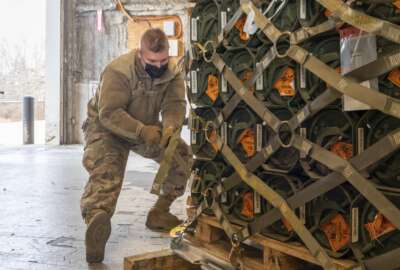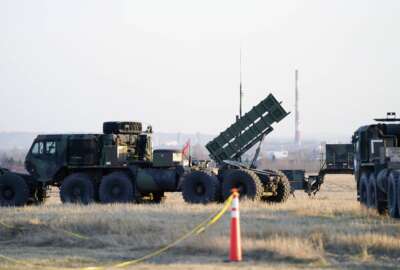How long can U.S. weapons and ammunition stockpile last?
The war in Ukraine, and to some extent Israel, have drained away U.S. weapons and ammunition stockpiles. Numerous studies have cited a shortage of shells, missiles...
The war in Ukraine, and to some extent Israel, have drained away U.S. weapons and ammunition stockpiles. Numerous studies have cited a shortage of shells, missiles and launch platforms, as well as whether the industrial supply chain and the military’s own organic supply chain have the capacity to sustain the demand. For one informed view, the Federal Drive with Tom Temin talked with Al Abramson, the Vice President of Strategic Engagement with the National Armaments Consortium and a retired U.S. Army brigadier general.
Interview Transcript:
Tom Temin Yeah, and a lot has happened since we spoke during the Association of the U.S. Army conference just a couple of months ago. That was just days after the terrorist attacks in Israel by Hamas. And we know what’s happened in suit in the world since then. And now there’s all these debates about what we do next in Ukraine, what is the armaments, especially the ordnance situation from the standpoint of the consortium these days?
Al Abramson We continue to roll forward. So the senior leaders within the Department of Defense a couple of years ago had already determined that we need to make sure that we have capabilities for today and into the future. And so not luckily, but with deliberate decision, those kinds of decisions to ensure we have enough capabilities not only for our warfighters but for our allies moving forward. We have enough in our supply chain now. Does the current geopolitical situation challenge some of that stuff? Absolutely. But we have a lot of folks watching that and watching our levels moving forward.
Tom Temin Well, there is a shortage now. Say let’s take the howitzer shell. That seems to be the commodity that a lot of these reports focus on, both news reports and think tank reports. And a lot of places make those. Does it take an international, I guess, sense of cooperation to have U.S. stockpiles refilled, but maybe by foreign manufacturers that can make the same specs type of shell because it’s an international commodity? Is that where we’re headed, do you think?
Al Abramson Those are decisions that clearly I don’t want to get in front of DoD and the State Department on making those decisions. But I do know that we do have allies that have the capacity to make those munitions and kind of mitigate some of that demand signal that we’re seeing today. But within specifically the field artillery ground that you’re talking about, the 155 round within the United States, we’ve already started to build a new shell plan, if you will, to get after some of that demand signal. But again, some of our allied partners have that capability. But that’s really a discussion with the State Department and OSD and the Department of Defense and how we do that partnership to have them build some technical specs that we own.
Tom Temin Because that capacity then can be built up relatively quickly. I was talking with someone else recently and they said, Well, we could build and create in some manner another submarine production capability, but it would take billions and billions of dollars in about six or ten years before it could start building submarines. Not quite that challenging in, say, the munitions area.
Al Abramson Sure, sure. Not that quite challenging, but still the process and the procedures and the EPA and all of those gates that you have to go through to go from a greenfield like nothing in there to an environment that has explosives and all of these things that can really hurt. It really is a process that has to undergo. And just why not use some of our allied nations, some of the things within the geopolitical realm that you kind of touched on? And I can go on and say with Taiwan, we have to look at Taiwan as well in 2025. We have some strategic partners in that region of the world that potentially we can partner with to build some of our munitions. But again, that’s a Department of Defense, State Department kind of decision.
Tom Temin And would it be fair to say that the armaments consortium maybe join some of the other groups and saying to the Pentagon, you need to have a much more steady demand signal and not a ramp up and then nothing for a few years. And then now we need 7 million new shells next year type of thing, but some kind of a steady approach to this so that there is that continuous supply chain and everything stays in spec and stays with an economic, you know, understanding.
Al Abramson You’re absolutely correct. Two points on that. As an acquisition professional myself, while I’m in uniform and now as the National Armaments Consortium, we’ve had the ability to speak with some of the DoD leadership. I know Department of Defense is going through a review. We spoke with the Army Science Board. And one of the things that’s just an example of the folks that we continue to speak with is the ability to stabilize funding predictability. Funding really does help the industrial base maintain those production levels without too much. What you don’t want to have is valleys and peaks of valleys and then a time of no water, if you will. And so being able to get across those particular areas are always good.
Tom Temin We’re speaking with retired Army Brigadier General Al Abramson. He’s now vice president of the National Armaments Consortium. And on more, even more current issue, the National Defense Authorization Act looks like they’ll avoid, you know, missing a year of 60 or so and getting that done in Congress. The consortium has had some reaction to that. And there’s some important provisions in the area of armaments and energetics. Maybe a quick review of what you see that’s important in the NDAA.
Al Abramson Yes. So one of the things that we see from a National Armaments Consortium perspective, this is the first time in a long time, at least from my perspective, that the Department of Defense and Congress, with the help of Congress, is really putting some verbiage, some policy out to get after tomorrow’s types of weapons and so that we’re no longer using yesterday’s explosive, yesterday’s propellants, but really getting after and investing in what we can do for over the horizon and into the future. And along with that is looking at our supply chain because we get some of those upstream chemicals from other nations that are no longer friendly to the United States. And how can we do to bring some of those chemicals into the continental United States or more friendlier nations?
Tom Temin Right. There is Section 242. It’s pretty high up in the bill. Consideration of lethality in the analysis of alternatives for munitions, I guess you wouldn’t want to have an alternative that’s less lethal or a weaker explosion just because the supplies are local.
Al Abramson That’s correct. And so one of those as a perfect lead into that is CL 20 is one of those things that people will talk about, which was made at China Lake. China Lake CL 20 was made at China Lake a couple of years ago and it has very good explosive characteristics. But we in the United States have not mastered the ability to make it at an affordable rate. And the language that we see now within the National Defense Authorization Act now will give some credence now will allow the Department of Defense to do some investment towards making that much more powerful, if you will, explosive at a much more affordable rate and potentially roll it into some of our weapons systems, which we currently don’t have in our weapon systems today.
Tom Temin I guess it’s easier to make it in a less stable fashion, but then it wouldn’t be safe for transport and so forth. The trick is getting that final processing in such a way that and that’s expensive that it can be practical to deploy.
Al Abramson Yeah. One of the things that’s actually pretty interesting that I learned is going from laboratory to benchmark and from bench to massive production, although we say it, there are some significant leaps and significant gates that need to be met and it’s not that simple. So although we can make CL 20 and investigate it at much smaller levels, to take it at a grand level to make technical term, maybe a couple of million pounds is an auspicious goal to be made and really needs to be looked at an industrial level.
Tom Temin And getting back to our original question about capacity and supplies, something in the NDAA section 245 is the authority to establish the Defense Industrial base munition surge capacity critical reserve. That’s a mouthful to procure long lead time items and components to accelerate delivery of munitions. This is in the bill.
Al Abramson And so another great language in the bill that will allow because within the acquisition community it’s called a bona fide need some of those long lead items. Until you get funded for said capability, you can’t purchase those long lead items until the funds come. But what this particular part of the bill allows us to do is, well, if we know something is coming, if we know that it’s coming, then it allows us to purchase ahead of time those items, those commodities that will take about 12 months to make, 18 months to make, and we’ll have them in stockage. So that means we will cut down on the manufacturing time to get after those explosive and those in the next gen capabilities. So I think that’s another powerful statement within the acquisition community to get capabilities out the door.
Tom Temin All right. Sounds like there’s a lot of moving parts here, though, but this is something of top concern in DoD is this whole supply chain for the things you shoot at the enemy.
Al Abramson And again, my short time in the military, specifically working within the acquisition community, I have not seen a concerted and combined effort to really address the supply chain issues that the military faces on a daily basis. Now, there’s challenges across the board, but again, just to see the language in there, which will migrate down into Department of Defense, senior leaders for us to get after this challenge, I think is a great thing looking forward, I think it’s an absolutely great thing and the right thing to do.
Copyright © 2025 Federal News Network. All rights reserved. This website is not intended for users located within the European Economic Area.
Tom Temin is host of the Federal Drive and has been providing insight on federal technology and management issues for more than 30 years.
Follow @tteminWFED







